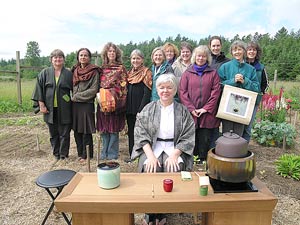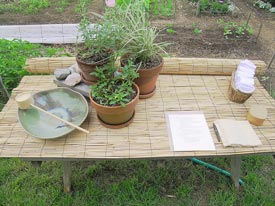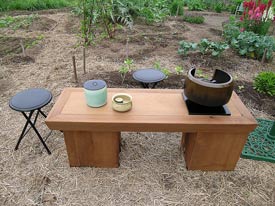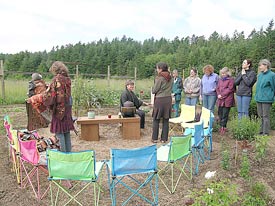|
A Japanese Tea Ceremony officially opens the summer talks in the garden.
 On
June 17th 2006, we had a Japanese Tea Ceremony in the garden to officially
open it for the summer "Saturday
Sunrise Talks in the Garden". An island friend, who has
been a student of tea since 1983, graciously responded to our request
of performing a tea ceremony as a way of honoring the garden. She was
able to adapt the formal ceremony that usually takes place in a traditional
tea room, for our garden setting. On
June 17th 2006, we had a Japanese Tea Ceremony in the garden to officially
open it for the summer "Saturday
Sunrise Talks in the Garden". An island friend, who has
been a student of tea since 1983, graciously responded to our request
of performing a tea ceremony as a way of honoring the garden. She was
able to adapt the formal ceremony that usually takes place in a traditional
tea room, for our garden setting.
We chose to hold it in our Heart Room which was large enough for 11
people to attend, plus our friend and her assistant. She brought all
of the beautiful bowls and utensils that she uses for the ceremony, as
well as a hand carved table, especially carved for her by a local artist.
We
sat near the garden entrance on benches that had been covered with bright
read felt fabric. Nearby was a small rectangular table with a bright
red silk cloth decorated with golden Oriental designs. On it was
her hand crafted guest book and the offering basket.
She proceeded to
explain the significance of the ceremony and the system that
we would be using to enter into a space of "harmony,
purity, and respect—the gateway to tranquility". There would
be no talking during the ceremony except by one person who was chosen
to ask questions that they thought the group might have. At the very
end there would be a time for questions by everyone.
We began
by walking around the outside perimeter of the garden, as I do
every morning before entering the garden. As I walk, I focus my
energy on my highest intention for the garden, keeping it in my heart,
until I have come full circle.
 We walked together in single file, until we reached the entrance
of the garden, where a table had been prepared with a beautiful bowl
of water and a wooden ladle for washing our hands and mouth. She showed
us how to do this and to let the last bit of water in the ladle flow
down the handle before setting it back down on the bowl. We could then
wipe our hands on a small towel the was folded neatly in a basket nearby.
She explained that this was a symbolic act of cleansing ourselves from
the "cares
of the world" before
entering into the garden and beginning the tea ceremony. We walked together in single file, until we reached the entrance
of the garden, where a table had been prepared with a beautiful bowl
of water and a wooden ladle for washing our hands and mouth. She showed
us how to do this and to let the last bit of water in the ladle flow
down the handle before setting it back down on the bowl. We could then
wipe our hands on a small towel the was folded neatly in a basket nearby.
She explained that this was a symbolic act of cleansing ourselves from
the "cares
of the world" before
entering into the garden and beginning the tea ceremony.
We
entered the garden in silence. As we all sat together in the Heart Room,
she told us about the scroll that was hanging nearby her. She had asked
me to choose a poem that would represent the intention of the ceremony.
I found a Rumi quote that felt just right.
"Try to be a sheet of paper
with nothing on it.
Be a spot of ground where nothing is growing,
Where something might be planted,
Possibly a seed,
From the Absolute."
We were then each given a little square of sweet cake
on a decorated napkin. Once we were all served we began, one by one to
partake of it, but only after saying the Japanese word that sounds like
"O-sock-a-knee" to the person to our left, which means please forgive
me for going before you. And then we would say "I will join you" to
the person on our right who had already partaken of their cake. Practicing
these two actions throughout the ceremony was a wonderful way to remember
to include and honor each other. Over the course of the next hour,
we all began to get the hang of it and began to shift into a subtle
deepening of our connection to each other.
 The
next phase of the ceremony was the making of the tea and the serving
of it in one of 4 bowls that had been chosen for the occasion. Each bowl
was symbolic in its shape, form and decoration. One was a special design
that had been used for hundreds of years in the Japanese Tea Ceremony.
Another was decorated with peach blossoms, another grape leaves, and
the last was the bowl that our friend had purchased for performing
her first tea ceremony. The
next phase of the ceremony was the making of the tea and the serving
of it in one of 4 bowls that had been chosen for the occasion. Each bowl
was symbolic in its shape, form and decoration. One was a special design
that had been used for hundreds of years in the Japanese Tea Ceremony.
Another was decorated with peach blossoms, another grape leaves, and
the last was the bowl that our friend had purchased for performing
her first tea ceremony.
The preparation of tea is like watching a master doing Tai Chi. Each
movement of the hand and each item that is used flow together in exquisite
grace and delicacy. For each cup of tea a little napkin, perfectly folded
and tucked in her waist band, was carefully taken out to wipe the top
of the little container holding the tea. It was then folded again with
exact movements of the hands and fingers, into its angular pattern and
tucked away. The little bamboo ladle which was used to scoop out the
green tea was set down perfectly, with honor and reverence. Prior
to the ceremony, I was asked, out of respect for the ladle, to choose
a name for it that would connect it to the garden. I chose the Japanese
name "tondo" for
dragonfly. At the end of the ceremony
there was a special time when this name was shared with the group.
Another important item in the ceremony is the iron tea kettle. It is
treated with utmost respect and is never to be touched with the hands.
When our friend came over with all of the items for the ceremony, they
were each neatly packed and handled with respectful care. She explained
then, that the kettle has a special role to play. Not only is its function
important, but it influences the flavor of the tea as well. The kettle
does have a lot of personality and surprisingly I found myself really
enjoying watching the steam float out of it and gently disappear—speaking
to me of the transient nature of life.
Water was caringly ladled out of the kettle, long handled bamboo ladle
placed in its exact spot, and whisk picked up carefully with
motions and timing designed centuries long ago, in order to froth
up the tea and water. Then each person was served a bowl by the assistant,
with attention to the back and front position of the bowl. We had been
instructed to receive the bowl with certain hand positions, to raise
it up above us in a gesture of giving thanks, to acknowledge the person
to the right and left as well as the tea master, and turn the bowl in
certain ways before drinking and returning it to the assistant. Each
position of back and front was designed to be a reminder of honoring
and respect between the assistant and participant.
 The tea ceremony has been likened to the Eucharist, because of the experience
of communion with the spirit within.
As I sat in the peace of the garden, with the sounds of the birds, and
gentle morning sunlight casting its first rays upon us, I was reminded
of the first times I took communion outdoors at the church camp of my
youth. The tea ceremony had worked as a catalyst for me to go within
and make contact with that which is holy inside myself. Participating
in the ceremony with others, as with communion, had given support to
the process and lent an extra benefit of spiritual bonding with each
other. When the ceremony was over each person left the Heart Room
and connected with our friend, where there was a moment for personal
words, tears, hugs and sharing. The look on our faces and the beautiful
silence was evidence of the sacred place that had been created. The tea ceremony has been likened to the Eucharist, because of the experience
of communion with the spirit within.
As I sat in the peace of the garden, with the sounds of the birds, and
gentle morning sunlight casting its first rays upon us, I was reminded
of the first times I took communion outdoors at the church camp of my
youth. The tea ceremony had worked as a catalyst for me to go within
and make contact with that which is holy inside myself. Participating
in the ceremony with others, as with communion, had given support to
the process and lent an extra benefit of spiritual bonding with each
other. When the ceremony was over each person left the Heart Room
and connected with our friend, where there was a moment for personal
words, tears, hugs and sharing. The look on our faces and the beautiful
silence was evidence of the sacred place that had been created.
The tea ceremony is a fabulous reminder that the intimacy created
by the practice of staying fully present in the moment is available all
of the time. It's just a matter of awareness and choice.
I have carried the wisdom of the tea ceremony into my gardening and
into my daily life. I feel so grateful to our friend for her skillfulness
and generosity of spirit. If you ever have the chance to experience a
tea ceremony, take advantage of it and see what happens for you.
| -jr6.jpg)
